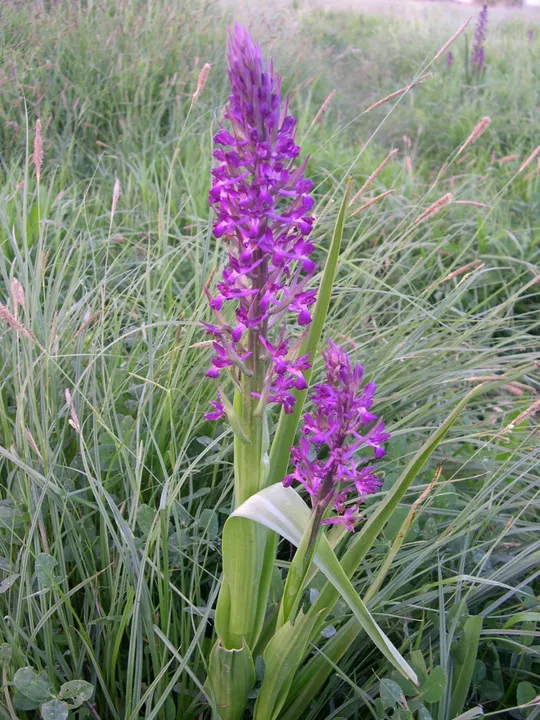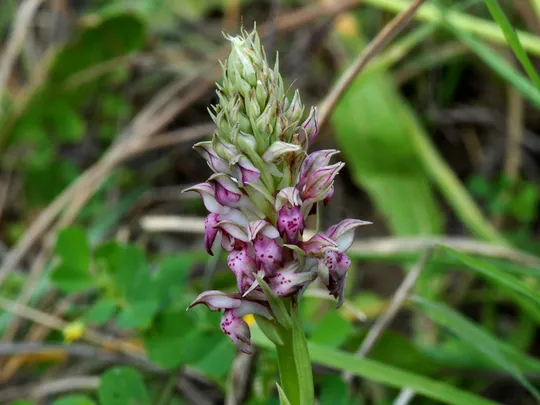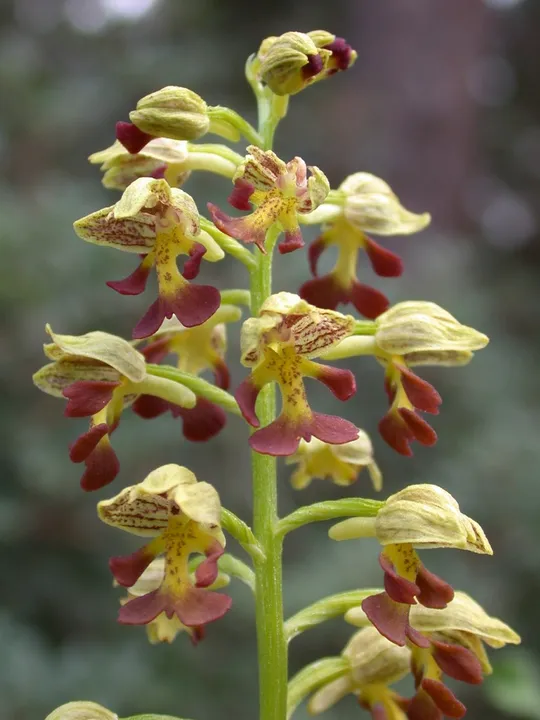Loose-flowered Orchid, Lax-flowered Orchid
Orchis laxiflora


Orchis laxiflora grows in 10
regions at 23 recorded sites, and according to estimates there are about 25
sites. In the Acre Valley, it is almost extinct and remains only in the Afek Reserve.
On the Carmel Coast, it remains in the Tel Sharish area north of Ma’agan Mikhael.
The largest concentration in the country survived in the Sharon in Ahu Binyamina,
in the Zeta marsh, at En Arubot and Enot Hogla.
It is extinct from the Pleshet coast, where it had been collected in 1920-50
from the Yarkon and Wadi Sorek areas. In the Lower Galilee O. laxiflora
is found at the Bet Lehem HaGlilit reservoir although it has disappeared from
Yodfat. In the Jezreel Valley it has almost disappeared from the Tishbi-Kfar
Yehoshua Junction and is extinct in the Ta’anakh Region and from the En Harod area.
In Ramat Menashe, O. laxiflora grows only in Wadi HaShofet. In the
lower Hermon, it is located in the area of the Hazuri springs and Mount Keta.
In the Golan Heights, it is known from the Hushniya springs and from the Samakh
Stream. In the Hula Valley, it gone from the Dan Stream, although it was found in
the Kiryat Shmona area, at En Bdolah, Lehavot HaBashan, Kfar Blum and Ahu Gonen.
In the Kinarot Valley, it is known only from En Balibel near
Mehola.
Heavy soils in moist locations, flooded in winter in Israel's
Mediterranean region. Fallow fields, riverbanks
and depressions in valleys.
Orchis laxiflora was described by Schlechter in 1844
and by Soo in 1927 as O. laxiflora var. dinsmorei (Flora Palaestina).
Subsequently its status was changed to an independent species – O. dinsmorei
(Bauman & Dafni, 1981), which differs from O. laxiflora in a number of
features, among them the shape of the labellum (divided into 3 lobes, the
middle one short), the plant’s height, the position of the other perianth
leaves and more. Feinbrun, in the Flora Palaestina, did not accept this
approach and included O. dinsmorei in O. laxiflora while noting the
name O. dinsmorei as a synonym for O. laxiflora. Recently Asaf
Shifman noted that the low Hermon populations are O. laxiflora while the other populations in the low areas of Israel
belong to O.dinsmorei (Shifman, 2009). The
morphological differences between the two species are mainly quantitative and
in most of them the two taxa overlap (Shifman, 2009). Recently plants were
found in the En Bdolah population in the Hula Valley, some of which looked like
O. laxiflora
and others that looked like O.dinsmorei, as well as intermediate forms, in the shape of
labellum as well. Consequently, all the populations in the country are presented
here as O. laxiflora. At the same time molecular analyses that were
conducted at the Kew Gardens in London led to an additional taxonomic change, the
transfer of O. laxiflora and other Orchis species to the genus Anacamptis
(Pridgeon et al, 1997). This change was accepted in several new publications,
including the major monograph on the genus Orchis and its relatives
(Krestzschmar et al. 2007). This publication also does not consider O. dinsmorei as an independent species, but
as a subspecies of Anacamptis laxiflora – ssp. dinsmorei.
·
Orchis laxiflora grew in the past
and grows today in relatively many regions in Israel, and among these it is
completely extinct from only one, Pleshet. However, in most of the regions in
which it still found there is a significant decrease of almost one-half, in the
number of sites from which it was previously known.
·
Most O. laxiflora populations are
small – from a few to tens of plants, with the exception of those found on Ahu Binyamina
site where the size of the population was formerly estimated at thousands, but
even at this site there has been a dramatic decrease in the number of plants.
·
The moist meadows and heavy flooded
soils habitat is slowly disappearing in Israel and the loss of the habitat
constitutes the main threat to the continued existence of O. laxiflora.
·
O. laxiflora is protected in
the En Bdolah, Tel Dan, Golan Iris-Hushniya, En Afek and En Arubot reserves.
The largest population of the species, in Ahu Binyamina, is located in a
proposed, but not yet declared reserve. The species is protected under the
wildflower protection law.
·
O. laxiflora is not
considered an endangered species in other countries.
Ahu Binyamina should
be formally declared a reserve. In addition, the patches in which Orchis laxiflora grows should be
marked as local conservation sites after checking that the species has indeed
survived there, for example at Kfar Yehoshua and the Tishbi Interchanges in the
Jezreel Valley and the Hula Valley sites.
Orchis laxiflora is found from Spain
to Central Asia. It is usually divided into three subspecies: the typical
subspecies – ssp. laxiflora – that grows in all the northern
Mediterranean Basin countries; in France and Spain it penetrates northwards to
the Euro-Siberian regions and is even found, although extremely rarely, in
southern of England. O.
laxiflora
is also found in Mediterranean Turkey, the Black Sea coast and Cyprus; the
subspecies dielsiana – grows in
eastern Turkey, the southern Caucasus, northern Iraq, Iran and in fragmented populations in Central Asia; the
subspecies dinsmorei – grows in western Syria, Lebanon and Israel .
Orchis laxiflora grows in moist, flooded heavy soils. There is a significant
decline in the number of its sites and its unique habitat is slowly
disappearing. O. laxiflora is a peripheral species whose main
distribution area is in northern Israel. The number of protected sites should
be increased.
ראה סחלב מצויר ורשימת הספרות הכללית
Current Occupancy Map
| 1000 squre meter pixel | 5000 squre meter pixel | 10000 squre meter pixel | |
|---|---|---|---|
| number of observations | 0 | 0 | 0 |
| in total pixels | 0 | 0 | 0 |
| Family | orchidaceae |
| Classification | On the endangered species list |
| Ecosystem | Mediterranean |
| Chorotype | Mediterranean – Irano-Turanian (Euro-Siberian) |
| Conservation Site | Ahu Binyamina, En Arubot, En Bdolah near Gome Junction |
| Rarity |
1
2
6
|
|---|---|
| Vulnerability |
0
2
4
|
| Attractiveness |
0
3
4
|
| Endemism |
0
0
4
|
| Red number |
1
4.7
10
|
| Peripherality | N |
| IUCN category | DD EW EX LC CR EN VU NT |
| Threat Definition according to the red book | Endangered |
 Based on:
Based on:






